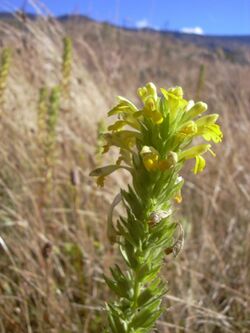Biology:Parentucellia viscosa
| Parentucellia viscosa | |
|---|---|

| |
| Scientific classification | |
| Kingdom: | Plantae |
| Clade: | Tracheophytes |
| Clade: | Angiosperms |
| Clade: | Eudicots |
| Clade: | Asterids |
| Order: | Lamiales |
| Family: | Orobanchaceae |
| Genus: | Parentucellia |
| Species: | P. viscosa
|
| Binomial name | |
| Parentucellia viscosa (L.) Caruel
| |
| Synonyms[1] | |
|
11, including: | |
Parentucellia viscosa is a species of flowering plant in the family Orobanchaceae known by the common names yellow bartsia[2] and yellow glandweed.[3] It is native to Europe, but it can be found on other continents, including Australia and North America, as an introduced species.
Description
This is an erect annual herb producing a stiff, slender stem coated in hairs and sticky glands. It reaches a maximum height of 50 to 70 centimeters. The hairy leaves are lance-shaped to oval and are lined with several teeth. The inflorescence is a raceme of flowers at the end of the stem. The flower is tubular, the calyx of sepals extending along most of the length of the corolla, which may exceed 2 centimeters long. The lobed, lipped corolla is yellow in color and glandular and sticky in texture.
The species is a root hemiparasite.[4] It is parasitic on plants in the Poaceae and Fabaceae, and inhibits the health of host species.[5]
References
- ↑ "Parentucellia viscosa (L.) Caruel | Plants of the World Online | Kew Science" (in en). https://powo.science.kew.org/taxon/urn:lsid:ipni.org:names:806705-1#synonyms.
- ↑ (xls) BSBI List 2007, Botanical Society of Britain and Ireland, https://bsbi.org/download/3542/, retrieved 2014-10-17
- ↑ "Parentucellia viscosa". Natural Resources Conservation Service PLANTS Database. USDA. https://plants.usda.gov/core/profile?symbol=PAVI3. Retrieved 30 January 2016.
- ↑ Pate, J. S.; Bell, T. L. (2000). "Host Associations of the Introduced Annual Root Hemiparasite Parentucellia viscosa in Agricultural and Bushland Settings in Western Australia". Annals of Botany 85 (2): 203–213. ISSN 0305-7364. https://www.jstor.org/stable/42770627. Retrieved 6 July 2022.
- ↑ Suetsugu, Kenji; Takeuchi, Yuko; Futai, Kazuyoshi; Kato, Makoto (September 2012). "Host selectivity, haustorial anatomy and impact of the invasive parasite Parentucellia viscosa on floodplain vegetative communities in Japan: HOST SELECTIVITY OF THE INVASIVE PARASITE". Botanical Journal of the Linnean Society 170 (1): 69–78. doi:10.1111/j.1095-8339.2012.01263.x. https://www.researchgate.net/publication/262873667_Host_selectivity_haustorial_anatomy_and_impact_of_the_invasive_parasite_Parentucellia_viscosa_on_floodplain_vegetative_communities_in_Japan. Retrieved 6 July 2022.
External links
Wikidata ☰ Q1459214 entry
 |

